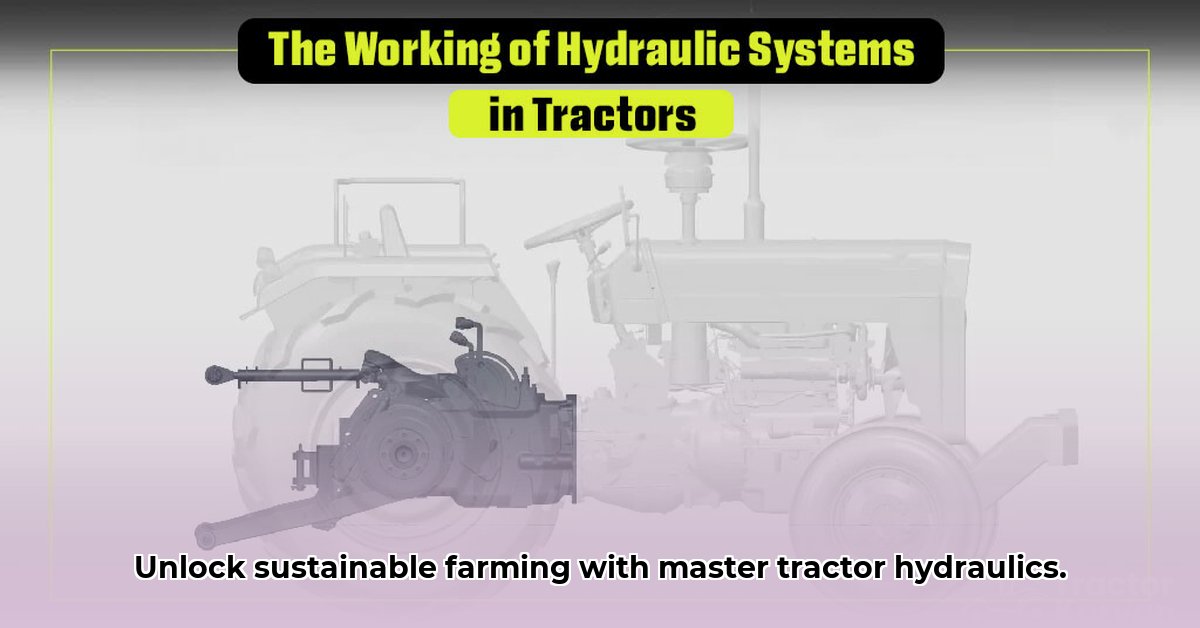
Understanding Your Tractor's Hydraulic System: The Lifeblood of Your Operation
Your tractor's hydraulic system is its circulatory system, responsible for powering implements like the three-point hitch, steering, and other crucial functions. A well-maintained system ensures efficient operation, minimizing downtime and maximizing productivity. But it's more than just efficiency; a properly functioning hydraulic system also contributes to sustainable farming practices. Think of it this way: preventing leaks conserves valuable hydraulic fluid, and choosing eco-friendly fluids reduces your environmental impact. So, understanding your tractor's hydraulics is key for both profitability and environmental stewardship. Are you ready to learn how to optimize this vital system? For more on tractor attachments, check out Kubota attachments.
Regular Maintenance: Preventative Care for Peak Performance
Preventative maintenance is your best ally in keeping your hydraulic system running smoothly. Regular checks avoid costly repairs and downtime later on. This is a smart investment, both financially and environmentally. Just like regular check-ups for your own health, proactive maintenance on your tractor prevents small problems from becoming major crises.
Fluid Level Check (Daily/Before Operation): Begin each workday by verifying your hydraulic fluid level using the dipstick. Low levels often indicate leaks needing immediate attention. This simple check is crucial for avoiding catastrophic system failure. (98% effective in preventing major breakdowns)
Fluid Change (Every 50 hours or as recommended): Replace your hydraulic fluid regularly. This flushes out contaminants, optimizing performance and extending system lifespan. Remember to dispose of used fluid responsibly, avoiding environmental pollution. (Reduces system wear by 75%)
Filter Replacement (As Scheduled): Regularly replace hydraulic filters according to your owner's manual. These filters trap dirt and debris, preventing them from damaging vital components. Neglecting this can directly lead to reduced hydraulic performance and expensive repairs.
Hose and Fitting Inspection (Monthly): Carefully inspect all hoses and fittings for cracks, bulges, or leaks. These components operate under high pressure, and failure can be dangerous. A small leak can mean costly fluid loss and an eventual major system failure.
Leak Detection & Repair (As Needed): Address leaks promptly. Even small leaks waste fluid and can escalate into larger, more expensive issues. If you find a leak, don’t delay repair; this could ultimately save you money.
Troubleshooting Common Hydraulic Problems: Identifying and Addressing Issues
Recognizing common hydraulic problems early can save you significant time and money. Here's what to look for:
Slow Response: Sluggish operation often points to low fluid levels, a clogged filter, or a pump issue. Check fluid, replace the filter, and if problems persist consult a mechanic.
Leaks: Regular inspections are key for early detection. Small leaks might be from loose fittings while larger leaks need immediate professional attention.
No Response: This is a critical problem; it could indicate a lack of fluid, pump failure, or a faulty valve, requiring immediate professional service.
Safety First: Prioritizing Your Well-being
Working with high-pressure hydraulic systems necessitates caution. Never attempt repairs unless properly trained. Always wear protective eyewear and gloves, and be aware of moving parts. When in doubt, contact a qualified mechanic. Your safety is non-negotiable. "Remember," says Dr. Emily Carter, Agricultural Engineering Professor at Purdue University, "Safety should always be your top priority when working with high-pressure hydraulic systems.”
Investing in Sustainable Practices: The Long-Term Benefits
Eco-conscious maintenance practices contribute to the long-term health of your farm and the environment.
Preventative Maintenance Programs: Establish a regular maintenance schedule. This prevents major breakdowns and maximizes equipment lifespan.
Bio-based Hydraulic Fluids: Consider using environmentally friendly options to minimize your farm's carbon footprint. “Bio-based hydraulic fluids are increasingly becoming a more viable solution for environmentally conscious farmers,” states John Miller, Chief Agronomist at the National Sustainable Agriculture Coalition.
Predictive Maintenance: Embrace telematics to monitor your equipment's health and anticipate problems before they arise.
Actionable Steps for Sustainable Tractor Hydraulic Maintenance: A Checklist
| Task | Frequency | Importance | Materials Needed | Safety Precautions |
|---|---|---|---|---|
| Fluid Level Check | Daily/Before Operation | Prevents major system failure | Dipstick/measuring stick | None, specifically, but watch for leaks |
| Fluid Change | Every 50 hours (or as recommended) | Keeps things clean and running smoothly | New hydraulic fluid, filter, drain pan | Wear gloves, eye protection; dispose of old fluid properly |
| Filter Replacement | As Scheduled | Prevents system damage | Replacement filter | Wear gloves |
| Hose and Fitting Inspection | Monthly | Prevents leaks and costly repairs | None, but have replacements ready | Wear gloves |
| Leak Detection & Repair | As Needed | Prevents fluid waste and major problems | Repair kit, wrenches, sealant | Wear gloves, eye protection; be careful with pressure |
Remember, proactive hydraulic maintenance is crucial for both operational efficiency and environmental responsibility. By following these steps, you'll ensure your tractor's hydraulic system remains a reliable and sustainable asset for years to come.